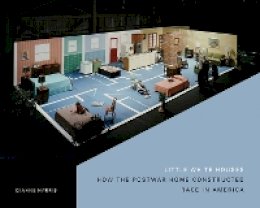
Stock image for illustration purposes only - book cover, edition or condition may vary.
Little White Houses: How the Postwar Home Constructed Race in America
Dianne Harris
FREE Delivery in Ireland
Description for Little White Houses: How the Postwar Home Constructed Race in America
Paperback. Series: Architecture, Landscape, and American Culture. Num Pages: 392 pages, 133 b/w illustrations. BIC Classification: 1KBB; 3JJP; HBLW3; HBTB; KFFR. Category: (G) General (US: Trade). Dimension: 203 x 254 x 23. Weight in Grams: 1089.
A rare exploration of the racial and class politics of architecture, Little White Houses examines how postwar media representations associated the ordinary single-family house with middle-class whites to the exclusion of others, creating a powerful and invidious cultural iconography that continues to resonate today. Drawing from popular and trade magazines, floor plans and architectural drawings, television programs, advertisements, and beyond, Dianne Harris shows how the depiction of houses and their interiors, furnishings, and landscapes shaped and reinforced the ways in which Americans perceived white, middle-class identities and helped support a housing market already defined by racial segregation and deep economic ... Read moreinequalities.
After describing the ordinary postwar house and its orderly, prescribed layout, Harris analyzes how cultural iconography associated these houses with middle-class whites and an ideal of white domesticity. She traces how homeowners were urged to buy specific kinds of furniture and other domestic objects and how the appropriate storage and display of these possessions was linked to race and class by designers, tastemakers, and publishers. Harris also investigates lawns, fences, indoor-outdoor spaces, and other aspects of the postwar home and analyzes their contribution to the assumption that the rightful owners of ordinary houses were white.
Richly detailed, Little White Houses adds a new dimension to our understanding of race in America and the inequalities that persist in the U.S. housing market.
Show Less
Product Details
Publisher
University of Minnesota Press
Series
Architecture, Landscape, and American Culture
Place of Publication
Minnesota, United States
Shipping Time
Usually ships in 7 to 11 working days
About Dianne Harris
Dianne Harris is an architectural historian and director of the Illinois Program for Research in the Humanities at the University of Illinois, Urbana-Champaign. She is the author of The Nature of Authority: Villa Culture, Landscape, and Representation in Eighteenth-Century Lombardy and the editor of Second Suburb: Levittown, Pennsylvania, among other books.
Reviews for Little White Houses: How the Postwar Home Constructed Race in America
"In this fascinating probe of the familiar suburban tract homes of the post–World War II era, Dianne Harris powerfully conveys how race and class were inscribed on the new metropolitan landscape. White middle-class America was born and raised in suburbia, a legacy we still live with today."—Lizabeth Cohen, author of A Consumers’ Republic: The Politics of Mass Consumption in Postwar ... Read moreAmerica "Impressively interdisciplinary and marvelously attentive to telling details, intimate lives, and social structures, Dianne Harris joins Dolores Hayden, Gwendolyn Wright, and others in making the architecture and landscape of everyday lives illuminate the workings of an entire historical period. Little White Houses is a blockbuster contribution to the critical study of whiteness and to the history of the United States after World War II."—David Roediger, author of How Race Survived U.S. History: From Settlement and Slavery to the Obama Phenomenon "Harris has contributed a major shift in perspective toward new and important ways to understand the history of postwar housing in the United States."—Antipode "Little White Houses establishes a clearly articulated framework which future studies may be informed..., general readers and academics alike should take great interest in her provocative and groundbreaking book."—Art Libraries Society of North America (ARLiS/NA) "Highly recommended."—Choice "Harris’ book should motivate scholarly discussions and discourse for continued work toward creation of a more civil American society."—Journal of Family & Consumer Sciences "[Harris’s] nuanced conception of the relationship between perceptions of racial identity, the federal systems of real estate financing, and the ways in which individual cultural choices defined the physical spaces associated with he single-family home is thoughtful and well-executed. However, the crucial correction to architectural histories that overlook the myriad roles race played in assumptions about design consistently marks the fundamental excellence of the text."—American Historical Review "[Harris] powerfully conveys the idea that socially conditioned personal, family, and even national identities are fashioned as much from material and spatial configurations of the home as from explicit political and cultural beliefs."—Journal of Architectural Education "Little White Houses is both lots of fun and incredibly valuable."—American Studies "Harris’s ingenuity in teasing out radical modern innovation, rapid historical change, and insidious ideological operations from the most mundane and familiar objects and arrangements is fascinating."—Traditional Dwellings & Settlements Review "Little White Houses offers an important contribution to the fields of suburban studies and whiteness studies, as well as to architectural history as a whole, providing a fresh look at the racial and classed dimensions of space and its representation and promotion during the postwar era."—Journal of American Studies "Few scholars have so effectively drawn attention to the most unremarkable aspects of the built environment. Harris has produced a book that will be sure to engage readers and influence scholarship for many years to come."—Buildings & Landscapes "An excellent look into the crucial role the spaces of the home played in American identity formation and, more specifically, how those identities were strongly shaped by the narrow vision of home life in the postwar world."—H-Net Reviews Show Less

